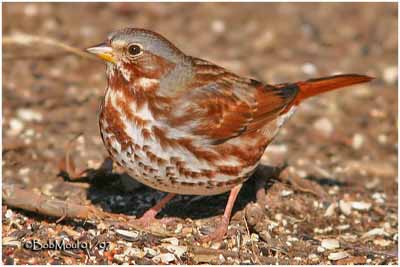
Fox Sparrow
Passerella iliaca
Passeriforme Order – Passerellidae Family
BIOMETRICS:
Length : 15-19 cm
Wingspan : 27-30 cm
Weight : 27-49 g
LONGEVITY: Up to 9 years
DESCRIPTION:
Fox Sparrow is a bulky bird, with strong, conical bill with yellow lower mandible, heavily streaked underparts, and no white in slightly notched tail.
Fox Sparrow is very variable in coloration of upperparts over its native range.
Fr: Bruant fauve
All : Fuchsammer
Esp : Sabanero Rascador
Ital: Passerella variabile
Nd: Roodstaartgors
Russe: Пестрогрудая овсянка
Sd: Rävsparv
Photographs by Bob Moul
His website: Nature Photography
Photographs by Tom Grey
His website : Tom Grey's Bird Pictures
Photographs by Tom Merigan
His website : Tom Merigan’s Photo Galleries
Text by Nicole Bouglouan
Sources:
FIELD GUIDE TO THE BIRDS OF NORTH AMERICA by National Geographic Society - National Geographic Society - ISBN: 0792274512
BIRDS OF THE GREAT BASIN – by Fred A. Ryser - Univ of Nevada Pr -ISBN: 0874170796
All About Birds (Cornell Lab of Ornithology)
Bird Web (Seattle Audubon Society)
What Bird-The ultimate Bird Guide (Mitchell Waite)
Wikipedia (Wikipedia, The Free Encyclopedia)

Passerella iliaca has broad rusty or dark brown streaking on mantle and underparts, bright russet rump and tail, mainly rusty brown wings (especially secondaries and great coverts), and grey tones to supercilium and sides of neck, that contrast with rusty brown ear coverts.
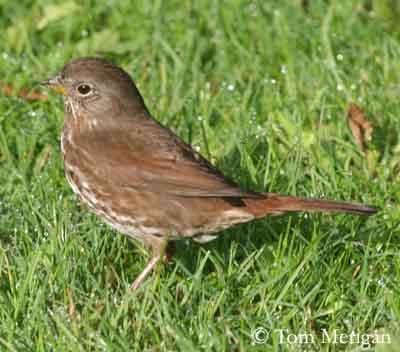
There are a large number of races in native range. Western races tend to be unstreaked above, and range from overall dark brown on head, upperparts and tail, to rusty on rump/tail, and either brown or grey on head/mantle.
There are 18 races divided into three large groups, genetically distinct, and with different songs.
Within each of the races, males and females are similar. Males are slightly larger than females. Juveniles are very similar to adults in appearance, with upperparts slightly duller, and smaller and narrower streaks on the breast.
In the genus Passerella, we can find 4 subspecies:

P.i. iliaca or Red Fox Sparrow, from Centre and East Coast. It winters in South-east of United States.
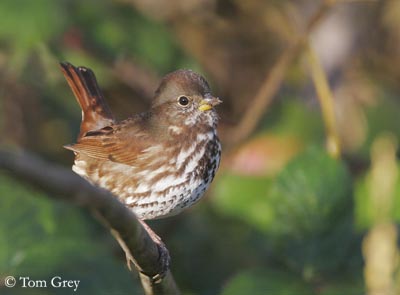
P.i.unalaschcensis or Sooty Fox Sparrow from West Coast. It winters from Alaska to California.

P.i. megarhyncha or Thick-billed Fox Sparrow from the Sierra Nevada. It winters in California.
P.i.schistacea or Slate-coloured Fox Sparrow from the Rocky Mountains. It winters in the arid areas of South-west. (not displayed)
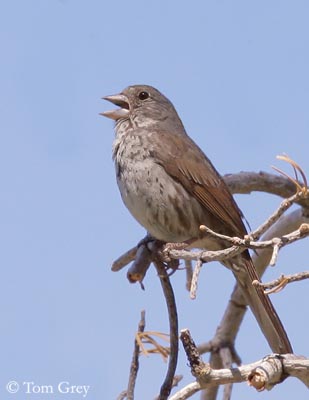
VOICE:
Fox Sparrow’s songs are sweet melodies in northern reddish races; include harsher trill in other races. Calls include a “chip”, a “click” and a drawn out “stsssp”.
Song is a series of loud, clear, melodious notes, gradually rising in pitch before falling away and often admixed with some buzzing trills.
Fox Sparrow has a voice that is thought to be one of the finest among sparrows.
HABITAT:
Fox Sparrow breeds in dense undergrowth, in both coniferous and deciduous woodlands, especially thickets by streams. It winters in forests, forest edges, and other woodland habitats with dense undergrowth. Fox Sparrow can be found in high elevations, especially in wet meadows or in scattered conifers.
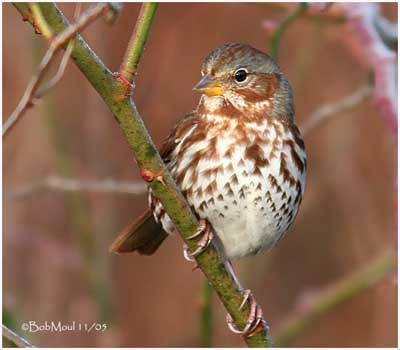
RANGE:
Fox Sparrow breeds across Alaska and British Columbia, eastward to New Brunswick and Newfoundland, southward in western mountains to Colorado and Central California, and also in Chaparral along Pacific coast from S Alaska to Baja California.
It winters in middle and southern of United States, from Minnesota to Massachusetts, southward to N Florida and S Arizona, and also along Pacific Coasts from Alaska to Baja California.
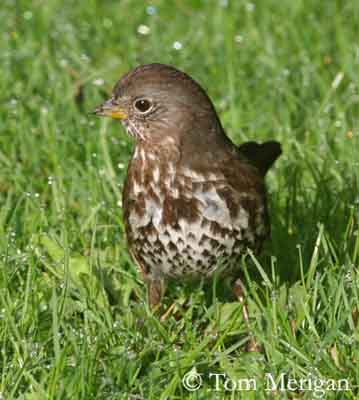
BEHAVIOUR:
Fox Sparrow is a shy and skulking bird, feeding on ground under cover of undergrowth, among leaf litter, often noisily kicking leaves backward with both feet to uncover food. It digs holes in the leaf litter and ground, to reach buried seeds or insects.
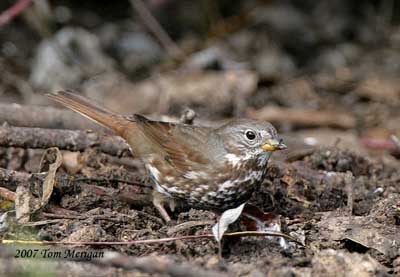
Male usually sings in its territory, keeping itself hidden. This shy bird only becomes defensive when its nest site is invaded by intruders. During breeding season, male is territorial and defends its nest site. It defends it by darting at the intruder, forcing it to leave.
Fox Sparrows are solitary or in pairs during breeding season, but they migrate in small flocks. They generally migrate at night, and sing during the day. It sings from a bush top, or on a low branch in a tree.
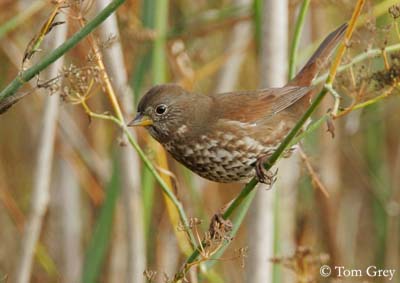
FLIGHT:
Fox Sparrow is a strong and direct flier. It alternates short flights of rapid wing beats, with brief periods with wings pulled to the sides.
REPRODUCTION:
Fox Sparrow’s nest is on the ground beneath dense shrubbery, or in very low branches, no more than 7 feet above ground. The cup-shaped nest is built by female, with twigs, dried grasses, stems, and bark. It’s lined with grass, animal hair and feathers.
Female lays 3 to 5 pale blue to pale green eggs, with thick brown spots. Incubation lasts about 12 to 14 days, mostly by female. Both parents tend and feed the chicks. The young fledge in 9 to 10 days after hatching. They leave the nest by jumping out and hopping away. Parents provide them food (mainly insects) and protection. Adults use the “broken wing” display to protect them from predators.
Fox Sparrows produce two broods per season.
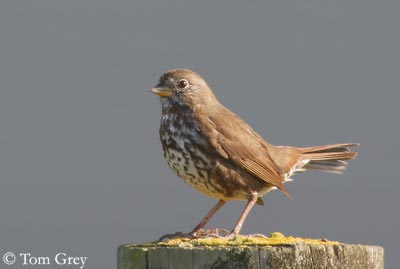
DIET:
Fox Sparrow is omnivorous. It feeds on seeds and insects, weed seeds, blueberries and other wild fruits. It also eats spiders, millipedes and small snails.
Birds on coastal areas may eat tiny crustaceans and other small marine animals found on the beach.

PROTECTION/ THREATS / STATUS:
With their nests placed on or near the ground, Fox Sparrows are preyed upon by hawks, mammalian carnivores and snakes. They are vulnerable to habitat destruction, and are occasionally parasitized by Brown-headed Cowbird.